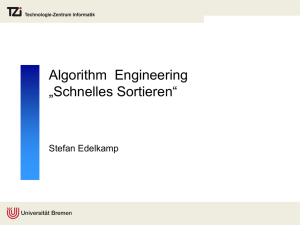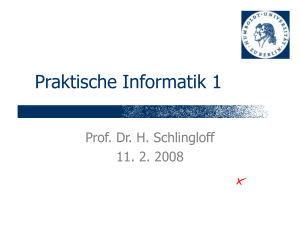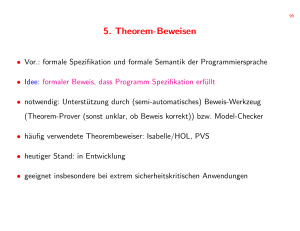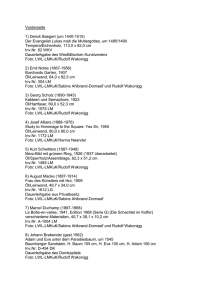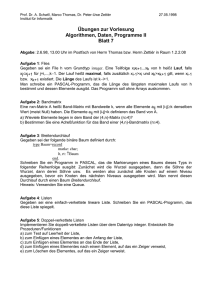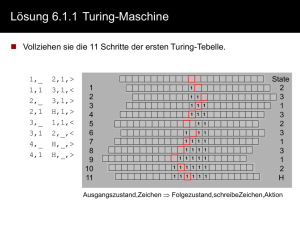AE-Sortieren
Werbung
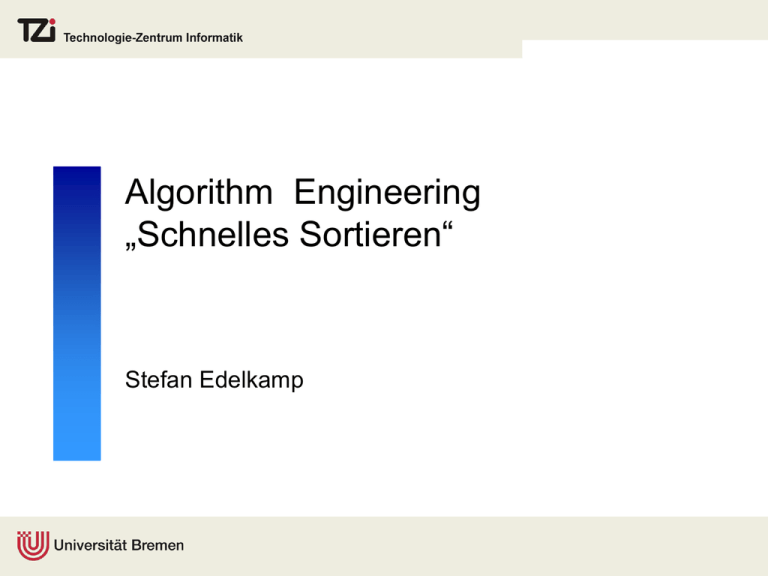
Algorithm Engineering
„Schnelles Sortieren“
Stefan Edelkamp
Überblick
Kriterien für Sortierverfahren
State-of-the-Art
Clever-Quicksort
Heapsort
Weak-Heapsort
Quick-Heapsort
Radix-Exchange-Sort
Sortieren durch Fachverteilung
Kriterien für Sortierverfahren
State-of-the-Art
State-of-the-Art (2)
State-of-the-Art (3)
Clever-Quicksort (Median-of-3)
Clever-Quicksort (Median-of-3)
Σ
Implementierung
Siehe Sedgewick:
The analysis of
quicksort
programs, Acta
Informatica,
Journal of
Algorithms,
15(1):76-100,
1993
Heapsort
Definition
Veranschaulichung
Entfernen
des Maximums
Versickern
Pseudo-Code
Erstellung eines Heaps
Äußere Schleife
Analyse Iteriertes Versickern
Σ
Analyse
Beobachtung
Bottom-UpHeapsort
Pseudo-Code (1)
Pseudo-Code (2)
Worst-Case
Average Case
Weak-Heap-Sort
Verschmelzen
Generieren
eines
Weak-Heaps
Sortierung
Arrayeinbettung
3 Fälle
Pseudo
Code
Analyse
Σ
Engineering
Quick-Heapsort
Quick-Heapsort
Σ
Σ
Pseudo-Code
Pseudo-Code (2)
PseudoCode (3)
RadixSort
Radix-Exchange-Sort
Beispiel
Unterscheidene
Präfixe
Analyse
Sortieren
durch
Fachverteilen
Analyse
Illustration
Pseudo-Code (1)
PseudoCode (2)
Adaptives Sortieren
Inversionen
Inv(X) = {(i,j) |
1 <= i < j <= n und
xi > xj}
Ziel AE:
1*n log (Inv(X)/n)+O(n)
Wenn Inv(X) = O(n²)
n log n + O(n)
Inversions-optimal
:= Laufzeit
O(n log (Inv(X)/n)+n)
Informationstheoretische
Grenze:
Ω(n log (Inv(X)/n)+n)
Kartesischer Baum
Der kartesische Baum TF
von F[1..n] ist ein geordneter „gewurzelter“
Baum mit n Knoten.
Der kartesische Baum des leeren Feldes ist der
leere Baum. Sei k = min (1,n).
Die Wurzel von TF ist markiert mit k, die Kinder
sind die kartesischen Bäume von
F[1..k −1] und F[k+1..n] (wobei F[i..j] das leere
Feld ist, falls j < i).
Konstruktion (a la wikipedia)
Process the sequence values in left-to-right order, maintaining
the Cartesian tree of the nodes processed so far, in a
structure that allows both upwards and downwards
traversal of the tree.
To process each new value x, start at the node representing
the value prior to x in the sequence and follow the path
from this node to the root of the tree until finding a value y
smaller than x. This node y is the parent of x, and the
previous right child of y becomes the new left child of x.
The total time for this procedure is linear, because the time
spent searching for the parent y of each new node x can be
charged against the number of nodes that are removed
from the rightmost path in the tree
Levcopoulos–Petersson Algorithmus
Konstruiere Karteschen Baums für die Eingabe
Initialisiere PQ mit der Wurzel des kartesischen Baumes
Solange PQ nicht leer:
1. Finde und lösche den min. Wert x in PQ (DeleteMin)
2. Gebe x aus
3. Füge die Kinder von x im kartesischen Baum zu PQ hinzu (Insert)
Zeit
Vergleiche
